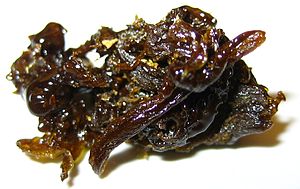大麻入り食品
Cannabis edible/ja
| Part of a series on |
| Cannabis |
|---|
 |
大麻入り食品(たいまいりしょくひん、cannabis edible)、または大麻注入食品(たいま-ちゅうにゅうしょくひん、cannabis-infused food)、単にエディブル(edible)とは、食品(自家製または市販のいずれか)に大麻抽出物を有効成分として含有させる脱炭酸カンナビノイド(カンナビノイド酸が経口的に生物活性型に変換されたもの)を加えたものを指す。エディブルは食品または飲料のどちらをも指すが、大麻注入飲料は、より具体的に液体エディブル(liquid edible)またはドリンカブル(drinkable)と呼ばれることがある。 エディブルは、大麻を摂取するために用いられるいくつかの方法の一つである。カンナビノイドが肺に吸入され、急速に血流に乗る喫煙とは異なり、約10分でピークに達し、数時間で効力が切れる。大麻エディブルは消化に数時間かかることがあり、その効果は摂取後2〜3時間でピークに達し、約6時間持続する。使用される食品や飲料は、摂取される量のタイミングと効力の両方に影響を与える可能性がある。
ほとんどのエディブルは、多量のTHCを含んでおり、これにより多様な作用が引き起こされる。これには、感覚知覚の高揚、リラクゼーション、眠気、めまい、口渇、多幸感、離人感および/または現実感喪失、幻覚、パラノイア、そして不安感の減少または増加が含まれる。THC優勢のエディブルは、嗜好目的および医療目的で消費される。THCをほとんど含まないエディブルもあり、代わりに他のカンナビノイド、特にカンナビジオール(CBD)が優勢である。カンナビス・エディブルの主な特徴は、喫煙によるカンナビスと比べて作用が現れるまでに時間がかかることである。
精神活性作用を持たない大麻製品から作られた食品や飲料はヘンプ食品として知られている。
歴史
東方

大麻を含む食品の最古の記録は、紀元前2000年のインドにまで遡る。最も古い大麻の伝統の一つとして知られるバングーは、ヨーグルト、ナッツ、香辛料、ローズウォーターを用いた大麻入り飲料であり、ホーリー祭の公式飲料である。ホーリー祭は、インドのヒンドゥー教コミュニティにおいてシヴァまたはカーリーを崇拝する盛大で神聖な祭りである。古代インド人は大麻抽出物が油脂に溶けやすいことも知っており、サンスクリット語のレシピには他の材料と混ぜる前にギーで炒める工程が含まれていた。
マジュン(大麻ジャム)は、もう一つの初期のエディブルであり、11世紀頃に北アフリカの遊牧ベルベル人部族によって初めて作られた。伝統的なマジュンのレシピには、大麻抽出物、ダチュラの種子、蜂蜜、ナッツ、キーフ(キーフの混合物)、さらに時にはデーツやイチジクが含まれる。
西方

ヨーロッパにおけるエディブルの最初の記録は、バルトロメオ・プラティナが1465年に著した料理本『De honesta voluptate et valetudine』(「名誉ある快楽と健康について」)に見られる。
アメリカ合衆国における最初の大麻エディブルのレシピは、1960年代初頭にアリス・B・トクラスが著した料理本『The Alice B. Toklas Cook Book』に登場した。「ハシシ・ファッジ」と呼ばれるそのレシピは、実際にはトクラスの友人であるブリオン・ガイシンによって寄稿されたものであった。このレシピはアメリカ初版では省かれたが、トクラスの名前と彼女の「ブラウニー」は、拡大する1960年代のカウンターカルチャーにおいて大麻と同義語となった。その後、多くの大麻料理本が出版された。
大麻が合法化された米国の一部の州では、エディブルの売上が劇的に増加した。エディブルはしばしば通常のキャンディに似ているため、子供が誤って摂取することがある。コロラド州で大麻が合法化された2009年から2015年の間に、10歳未満で大麻曝露により病院や中毒センターで治療を受けた子供の数は5倍に増加した。これらの事例の半数以上にエディブルが関与していた。用量のばらつきや効果発現の遅れ(これにより追加摂取を行ってしまう)が、特に子供や経験の浅い使用者において過剰摂取を引き起こすことがある。2008年以降、犬がエディブルを摂取したことによる中毒管理センターへの通報も急増している。カナダでは2018年10月に大麻入り食品が合法化されたが、規制上の制限や消費者の関心低下が革新を妨げる可能性がある。
化学
Effects
Ingesting cannabis may produce effects that last longer and can be more intense than inhaling cannabis. Different edible formats of cannabinoids may affect the rate of cannabinoid digestion and metabolism, which vary among people. Generally, edible cannabis products are digested more slowly than occurs for aerosol products. Oral administration generally leads to two peaks of concentration, due to enterohepatic circulation. Common side effects of ingesting edibles include increased appetite, dry mouth, and bloodshot eyes.
Possible health effects
Cannabis edibles contain both delta 9 THC, which is responsible for the psychotropic properties of feeling relaxed and euphoric, and CBD, which may have effects without the psychoactive properties. Such effects may include analgesia, decreased inflammation, decreased spasticity, and anti-seizure effects. Cannabis edibles with CBD can decrease symptoms of psychosis and anxiety. Edible oils, tinctures, pills, and gummies have been prescribed to people with cancer to potentially improve poor appetite, pain, or weight loss. Cannabis edibles may be effective for muscle spasms and pain.
Possible side effects
Some users of cannabis have reported adverse effects, such as confusion, hallucinations, panic attacks, paranoia, and intense psychotic effects. Cannabis may cause short-term impairments in cognition, memory, alertness, coordination, and balance which can increase risk of falls, especially in older people, and make driving a car dangerous.
Overdoses may occur because the dosage of THC in edibles is impossible to determine without specialized lab equipment and it varies from product to product. Some or all legalized U.S. states require packaged edibles to have dosage on the label; for instance California AB266 requires labeling to include "THC and other cannabinoid amount in milligrams per serving, servings per package, and the THC and other cannabinoid amount in milligrams for the package total", and states have required the recall of incorrectly labeled products. Overdoses can cause behavioral impairments, such as paranoia, impaired mobility, and nausea. Other risks, as a result of regular long-term cannabis use, include harmful effects to brain development, heart function, memory and cognition, and psychiatric health.
Long-term recreational marijuana use can cause cognitive impairments and also lead to cannabis use disorder (CUD). Symptoms of CUD include lack of motivation, decreased concentration, and loss of interest in other activities, tolerance, and dependence.
Types
Edible infusions
Food


The important base to all food edibles is that it has fat that has been infused with THC. In other words, any food that contains butter, oil, milk, or any fatty substance can be turned into an edible. Examples of cannabis-infused foods include baked goods, candy, potato chips, and more. One may not be able to distinguish between regular baked goods and those containing cannabinoids. A mild grassy or cannabis flavor might be detectable if sufficient cannabis quantities are used.
Dawamesc is a cannabis edible found in Algeria and some other Arab countries, made of cannabis tops combined with: "sugar, orange juice, cinnamon, cloves, cardamom, nutmeg, musk, pistachios, and pine nuts."
Happy pizza is a style of pizza in Cambodia which includes cannabis-infused ingredients and has enough THC for psychoactive effects.
Cannabis-infused brownies contain cocoa solids which forms a polysubstance combination.
Drink

A cannabis-infused drink is a drink infused with THC and can be as potent as a cannabis-infused food.
In U.S. states that have legalized cannabis for recreational use, drinks were about 4% of the cannabis market in 2014 but had fallen to around 1.5% of the market in 2016. Cannabis infused drinks can come in the form of coffee, tea, soda, and alcohol. THC-infused seltzers, a rapidly growing category of cannabis beverages, are becoming increasingly popular as an alternative to alcohol.
Tincture
According to the European Medicines Agency (EMA) cannabis tinctures (tincturea) are a type of liquid cannabis extract obtained using ethanol, water, glycerol, propylene glycol and fatty oils as extraction solvents, depending on the type of tincture (and also on the solvent used) it can have a specific mass/volume ratio or a specific therapeutic agents content. Tinctures are potent, alcohol-based cannabis extracts. The solubility of THC in ethanol is greater than 1 g/mL. They are considered edibles as they are meant to be absorbed through the mouth and tongue. Tinctures are generally placed under the tongue using a dropper to allow it to be absorbed into the bloodstream. Tinctures can be added to any food or drink and provides more control over the cannabis dosage compared to cannabis-infused foods or drinks.
Dissolvable cannabinoid powder
Dissolvable cannabinoid powder is tasteless and odorless, and may elicit effects typical of oral cannabis products. Powders are water-soluble and can be mixed into foods and drinks. Unlike traditional edibles which can take some 90 minutes to take effect, cannabinoid powder may produce effects within 20 minutes due to solubility and uptake of the powder constituents via the digestive tract, allowing rapid effects, especially of THC.
CBD edibles
Cannabidiol (CBD) edibles are non-psychoactive and non-intoxicating, and contain varying amounts of THC, according to the manufacturer. These edibles provide the effects of cannabis without the psychoactive response to THC.
Capsule
Cannabis capsules are considered edibles as they are also metabolized in the gut. Capsules can contain either THC or CBD and are an easier, more convenient way of administering products.
Oil
Cannabis oil, or canna-oil, is a product that combines oil with THC. This combination is achieved through a process of infusion, where the THC is extracted from the flowers or concentrates and then added to the oil. The resulting product is a liquid that can be consumed orally, used as a cooking ingredient, or applied topically. Coconut oil is a commonly used oil for infusion, but other options are olive, avocado, and walnut oil.
Butter
Cannabis butter, or cannabutter, is unsalted butter blended with cannabis and water. Cleaned and dried buds are steeped in melted butter or oil in preparation for consumption. Cannabutter can be added to any baking recipe.
Safety
Physical
The adverse effects on health are most important when it is used in excessive quantities or with heavy frequency. A study funded by the National Institute on Drug Abuse entitled "Tasty THC: Promises and Challenges of Cannabis Edibles" found that heavy, long-term cannabis use appeared to worsen brain development, and psychiatric and heart health. On the other hand, the study also discovered that cannabis edibles did not appear to affect pulmonary function nor increase risk for cancer which is one reason people choose cannabis edibles over smoking cannabis. The study concedes that over-consuming cannabis is not lethal; to date, there has never been a death related to the actual toxicity of cannabis. However, there has been one death involving cannabis edibles.
A safety concern with regards to cannabis edibles is overconsumption which is usually caused by the delayed effects of ingested cannabis. Because users do not feel the effects of cannabis edibles immediately, users may eat more to compensate and end up consuming too much THC. As a result, cannabis edibles as such have caused the most healthcare visits as compared to other forms of cannabis consumption.(Additionally, the amount of THC in any individual product may be highly variable.) Additionally people can have very different responses to the same amount of THC with 2.5 mg being enough for some people to begin to feel effects whilst, for others, 50 mg is required. Thus typical advice for newcomers is to "start low and go slow" in order to gauge the over-all initial effects, with 5–10 mg being one neophyte range.
Psychological
High concentrations of THC have been shown to cause hallucinations, delusions, and anxiety in some people; for most, these symptoms only last as long as that person is intoxicated, but some people can be affected for several days. Cannabis use has been connected with increased use of other drugs, although this connection has never been shown to be causal.
Children
Many edible cannabis products are packaged in a way which could appeal to children (gummies, etc.), though laws requiring a minimum age to purchase recreational cannabis are universal in jurisdictions that have fully legalized its use, similar to age restrictions on alcohol. As with alcohol and prescription medicines, care should be taken to prevent children from having access to the product, as cannabis edibles have been the main cause of a number of health care visits relating to accidental cannabis consumption by children. In 2022, the US National Poison Data System reported about 6,000 people calling for help after children under the age of 13 ate cannabis edibles, compared to 1,800 calls for CBD and 2,000 for dried marijuana. Children under the age of 5 who ate cannabis edibles is the largest source of marijuana-related calls to poison centers (36% of calls about marijuana product exposures in 2021). Although 65% of calls about a child under 13 who had consumed edibles ultimately involved no or only minor effects, almost 3% involved a child who was experiencing life-threatening symptoms or a similar major effect from consumption of the edibles. About 60% of these calls resulted in medical evaluation, and 20% resulted in hospitalization.
Cannabis intoxication in children under 10 is primarily due to unintentional intoxication through cannabis edibles, such as a child eating what appears to be candy. In such cases, it is typically the only drug consumed by the child, and is much more likely to result in hospitalization than in teenagers. 2023年現在[update], many children have needed care in an intensive care unit, including intubation. Although deaths and other serious outcomes are "rarely reported", at least one child has died from eating THC gummies.
関連項目
外部リンク
- Beyond brownies: Cannabis chefs elevate edibles recipes. San Francisco Chronicle. 2018-10-09.
| この記事は、クリエイティブ・コモンズ・表示・継承ライセンス3.0のもとで公表されたウィキペディアの項目Cannabis edible(2025, at 13:58編集記事参照)を翻訳して二次利用しています。 |



